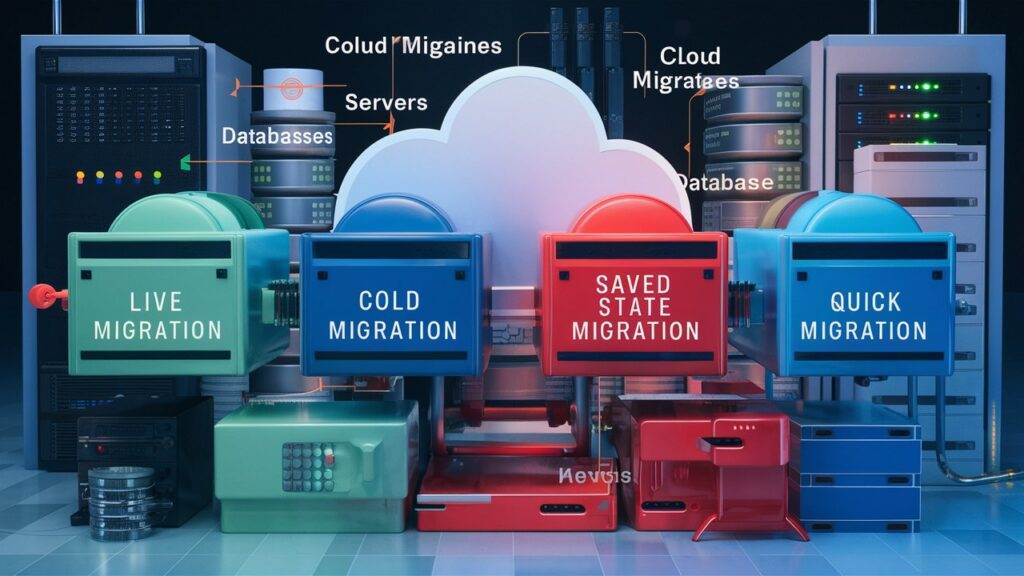Discover the key differences between hot and cold VM migrations in cloud computing, including how each method impacts virtual machine transfer efficiency. Learn about the benefits and challenges of both migration techniques to optimize your cloud-based migration strategy.
Understanding VM Migration and Its Relevance
Defining Virtual Machine (VM) Migration
Virtual Machine (VM) Migration is the process of moving a virtual machine from one physical host to another within a cloud environment. This is key in virtualization, letting multiple virtualized systems run on one physical machine. In today’s data centers, VM migration helps manage resources better.
In virtualization, there are two main types of VM migration: live migration and non-live migration. Live migration moves a running VM without any downtime, keeping services available. Non-live migration involves shutting down the VM before moving it to another host. This is used when some downtime is okay or can’t be avoided.
VM migration is important in networked systems and cloud computing setups like Infrastructure as a Service (IaaS) and Platform as a Service (PaaS). It allows dynamic load balancing by spreading workloads across different servers. This optimizes resource use and boosts system performance.
Significance of VM Migration in Cloud Computing
VM migration is crucial in cloud computing for many reasons:
- Server Consolidation: By moving VMs from less-used servers to more efficient ones, cloud providers can consolidate servers and cut costs. This improves resource allocation and saves energy.
- Workload Mobility: The ability to move workloads smoothly across different hosts ensures optimal resource use. This flexibility is vital for maintaining performance during peak times.
- Downtime Minimization: One big benefit of live VM migration is reducing downtime during maintenance or unexpected failures. Services stay up without interruptions, which is critical for businesses needing high uptime.
- High Availability: VM migration supports high availability by enabling quick recovery from hardware issues. If there’s a risk of failure, VMs can be moved to healthy hosts, ensuring continuous service.
- Disaster Recovery: In disaster recovery scenarios, VM migration allows fast relocation of important workloads to safe environments. This ensures business continuity even under adverse conditions.
By using these advantages, organizations can achieve better performance, cost efficiency, and reliability in their cloud computing infrastructure.
Hot VM Migration- A Live Approach
Overview of Hot VM Migration
Hot VM Migration, also known as Live Migration, lets you move a running virtual machine (VM) from one physical host to another with minimal downtime. This process keeps services available and operational during the migration.
Concept and Process
Hot VM Migration involves a few methods:
- Pre-copy Method: Memory pages of the VM are copied to the destination while the VM is still running on the source. After most memory has been transferred, the VM pauses briefly to copy any remaining pages.
- Post-copy Method: The VM pauses at the beginning, and its execution state transfers to the destination. The remaining memory pages are copied over while the VM resumes operation on the new host.
- Hybrid Method: Combines both pre-copy and post-copy techniques to optimize performance and reduce downtime.
Benefits of Hot Migration
Hot Migration offers several advantages:
- Minimal Downtime: Transferring VMs with minimal interruption ensures continuous service availability. This is vital for applications needing high uptime.
- Real-Time Data Transfer: Data is transferred in real-time, preserving all changes made during migration.
Implementation Options
There are various methods to implement Hot VM Migration:
Shared Storage Migration
Shared Storage Migration uses a common storage system accessible by both source and destination hosts. This method simplifies data transfer as only memory and CPU states need migrating.
Remote Direct Memory Access (RDMA) Migration
RDMA allows direct memory access from one computer into another without involving either one’s operating system. This method provides high throughput and low latency, making it suitable for fast migrations.
Virtual Private Network (VPN) Migration
VPN Migration uses encrypted tunnels over public or private networks to securely transfer VMs between hosts. This method ensures data security during migration, essential for sensitive applications in cloud computing environments.
By understanding these concepts and methods, organizations can effectively use hot migration techniques for optimized performance and minimal downtime in their networked systems or cloud data centers.

Migration Techniques
Different techniques can be used for cold VM migration, each with its own set of benefits and use cases.
File-Based Migration
File-based migration involves transferring individual virtual disk files from one storage location to another. This method is straightforward but may require significant time if large volumes of data are involved.
Benefits:
- Virtual Disk Migration: Easily migrates specific virtual disks without affecting others.
- Simplicity: Simple and easy-to-understand process.
Image-Based Migration
Image-based migration creates a complete image of the VM, which includes all its settings and data. This image is then transferred to the new host.
Benefits:
- Comprehensive Transfer: Ensures all aspects of the VM are moved together.
- Efficiency: Can be faster than file-based methods for large VMs.
Snapshot-Based Migration
Snapshot-based migration involves taking a snapshot of the VM at a specific point in time and then migrating this snapshot.
Benefits:
- Point-in-Time Accuracy: Captures the exact state of a VM at a given moment.
- Rollback Capability: Allows easy rollback if something goes wrong during migration.
Hybrid Migration
Hybrid migration combines elements from different methods, such as using snapshots along with file transfers or integrating cloud services.
Benefits:
- Hybrid Cloud Integration: Facilitates seamless integration between on-premises data centers and cloud environments.
- Flexibility: Offers greater flexibility in how migrations are performed, catering to complex scenarios.
Hot vs. Cold Migration- Making the Right Choice
Comparison of Hot and Cold Migration
Hot Migration, also known as Live Migration, lets virtual machines (VMs) move from one host to another without shutting down. This method ensures minimal downtime, which is great for critical applications needing continuous availability.
On the other hand, Cold Migration involves shutting down the VM before moving it to a new host. While simpler and less resource-intensive, it causes some downtime that might impact business operations.
Key Differences:
- Downtime Impact: Hot Migration offers near-zero downtime. Cold Migration requires VMs to be offline during the process.
- Data Integrity Considerations: Both methods ensure data integrity. However, Hot Migration needs more robust networked systems to handle live data transfer.
- Resource Requirements: Hot Migration demands higher CPU and memory resources compared to Cold Migration.
- Performance Metrics: Performance during migration is generally better with Cold Migration due to fewer resource constraints.

Choosing the Optimal Migration Method
Selecting between Hot and Cold Migration depends on several factors including urgency, application sensitivity, and infrastructure capabilities.
Migration Urgency:
- If immediate migration is necessary with minimal disruption, go for Hot Migration.
Application Sensitivity:
- Applications requiring high uptime should opt for Hot Migration.
Infrastructure Capabilities:
- Evaluate your networked systems’ ability to handle live migrations without performance degradation.
Factors to Consider
When planning a migration strategy, keep these essential factors in mind:
- Migration Planning: Develop a comprehensive plan outlining each step of the migration process.
- Capacity Planning: Ensure your infrastructure can handle additional loads during migration.
- Performance Monitoring: Continuously monitor system performance to identify potential bottlenecks.
Case Studies and Examples
Looking at real-world examples can provide valuable insights into choosing the right migration method:
- Case Study 1: A financial institution successfully used Hot Migration for their trading systems to ensure zero downtime during market hours.
- Case Study 2: A manufacturing company opted for Cold Migration during off-hours for their ERP systems due to limited infrastructure capabilities.
For further reading on these topics, refer to recommended publications by featured authors in leading research journals.
By understanding these aspects and evaluating your specific needs, you can make an informed decision on whether Hot or Cold Migration is best suited for your organization’s requirements.
Future of VM Migration in Cloud Computing
Emerging Trends and Advancements
Virtual Machine (VM) migration technology is evolving rapidly, with several emerging trends and advancements reshaping the landscape. One significant trend is container-based migration. Containers allow for better resource utilization by encapsulating applications and their dependencies into a single, lightweight unit. This approach simplifies the migration process and enhances efficiency.
Automated migration tools are another major advancement. These tools streamline the complex steps involved in migrating VMs, reducing manual intervention and minimizing errors. By automating tasks such as data transfer, configuration adjustments, and testing, these tools save time and resources.
Serverless migration is also gaining traction as a cutting-edge approach. In a serverless environment, developers can focus on writing code without worrying about the underlying infrastructure. This paradigm shift allows for more flexible scaling and reduces operational overhead.
Predictions and Impact on IT Infrastructure
Looking ahead, VM migration will significantly impact IT infrastructure. Increased efficiency and scalability are at the forefront of this transformation. As automated tools become more sophisticated, businesses can migrate workloads faster and with fewer disruptions. This increased agility allows organizations to scale their operations seamlessly.
Improved disaster recovery capabilities are another critical benefit. With advanced VM migration techniques, companies can ensure business continuity by quickly moving workloads to safe locations during emergencies. This reduces downtime and mitigates potential losses.
Enhanced cloud adoption is expected as these advancements make it easier for businesses to transition to cloud environments. By simplifying the migration process and improving reliability, more organizations will be encouraged to adopt cloud solutions across various industries.
In summary, staying updated with emerging trends in VM migration technology is crucial for leveraging its full potential in cloud computing environments. Container-based migration offers better resource utilization, automated tools simplify processes, and serverless approaches provide flexibility. These advancements lead to increased efficiency, improved disaster recovery capabilities, and greater cloud adoption—transforming IT infrastructure for the better.

